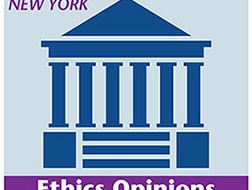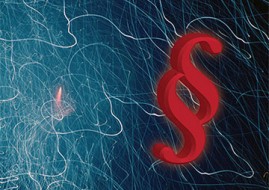How to Lose Your Legal Fee, Part 2: Legal Fee Forfeiture
In our February 2016 edition, we published the first of a three-part series of articles on “How to Lose Your Legal Fees.” That article examined excessive fees, focusing on how the interplay between New York Rule of Professional Conduct 1.5(a) and common law contract and fiduciary duty rules can result in contractual legal fees being disallowed. In this article, we will explore a more common, and in some ways more frightening scenario: legal fee forfeiture.
Thirteen years ago, I wrote an article, “What Do You Mean I Don’t Get Paid? Fee Forfeiture in New York,” New York Professional Responsibility Report (March 2003) at 1, exploring this same issue. At the time, I noted that “fee forfeiture remains a well-kept secret, … occur[ring] far less frequently than motions for sanctions or disqualification,” and with a far less developed and often confused body of case law. Since then, two important decisions, Phansalkar v. Andersen Weinroth & Co., L.P., 344 F.3d 184 (2d Cir. 2003) (Phansalkar) and Ulico Casualty Co. v. Wilson, Elser, Moskowitz, Edelman & Dicker, 56 A.D.3d 1 (1st Dept. 2008) (Ulico), have raised attorneys’ consciousness to the potency of fee forfeiture as a weapon between lawyers (as well as other types of fiduciaries) and their clients, while placing procedural limitations on its power. Today, the case law remains just as unclear, and fee forfeiture is more difficult to obtain, than it was in 2003.
Basics of Fee Forfeiture
Fee forfeiture arises in many contexts: as a basis for a client’s refusal to pay a lawyer fired for cause; as a ground for refusing to allow outstanding fees to offset a malpractice judgment; as a defense to a lawyer’s claim for fees; and, most commonly, as a remedy in a client’s lawsuit for breach of fiduciary duty. However it arises, fee forfeiture is solidly grounded in principles of agency law. As the New York Court of Appeals stated in 1886: “An agent is held to uberrima fides in his dealings with his principal, and if he acts adversely to his employer in any part of the transaction … it amounts to such a fraud upon the principal, as to forfeit any rights to compensation for services.” Murray v. Beard, 102 N.Y. 505, 508 (1886); see Restatement (Second) of Agency §469 (1958) (an agent who breaches his duty “is not entitled to compensation even for properly performed services for which no compensation is apportioned”).
The attorney-client relationship, as a species of agency, is covered by the same rule. See Campagnola v. Mullholland, Minion & Roe, 76 N.Y.2d 38, 44 (1990) (rule that attorney fired for cause may not receive fees is “‘well-calculated to promote public confidence in the members of an honorable profession whose relation to their clients is personal and confidential’”) (citation omitted); Restatement of the Law Governing Lawyers, §37, comment b (“The remedy of fee forfeiture presupposes that a lawyer’s clear and serious violation of a duty to a client destroys or seriously impairs the client lawyer relationship and thereby the justification for the client’s claim of fees”).
At their core, the New York rules of fee forfeiture are simple and clear. “An attorney who engages in misconduct by violating the Rules of Professional Conduct (RPCs) is not entitled to legal fees for any services rendered.” Shelton v. Shelton, 151 A.D.2d 659 (2d Dept. 1989). Thus, lawyers have forfeited their fees when they had a conflict of interest [see, e.g., Quinn v. Walsh, 18 A.D.3d 638, 648 (4th Dept. 2000); Matter of Winston, 214 A.D.2d 677, 677 (2d Dept. 1995)], violated the “attorney-witness” rule of RPC 3.7 (formerly DR 5-102) [Brill v. Friends World College, 133 A.D.2d 729, 730 (2d Dept. 1987], violated the “no contact” rule of RPC 4.2 (formerly DR 7-104 (A)(1)) [Estate of Satin, 265 A.D.2d 330, 330 (2d Dept. 1999)], and repeatedly made misrepresentations to the court. In re Food Mgmt. Group LLC, Adversary No. 06-08470A, 2008 WL 2788738 at *13-14 (Bankr. S.D.N.Y. 2008). On the other hand, mere disagreements between a client and a lawyer about strategy [e.g., Callaghan v. Callaghan, 48 A.D.3d 500, 501 (2d Dept. 2008)], and other distasteful conduct not involving an RPC violation [Orendick v. Chiodo, 272 A.D.2d 901, 902 (4th Dept. 2000) (lawyer’s post-discharge communication with another attorney, hoping to enlist his help in winning client back, but where no confidential information disclosed) will not result in forfeiture. Forfeiture can result from misconduct that occurs before an attorney’s discharge but is not discovered until after the discharge. Coccia v. Liotti, 70 A.D.3d 747, 757 (2d Dept. 2010, citing Orendick, supra].
Courts, however, are not always willing to follow these simple rules, which appear to create an “all-or-nothing” approach to fee forfeiture: either the attorney did something wrong and loses everything, or the attorney did nothing wrong and keeps the entire fee. Whether they will do so in a particular case often depends on the procedural context in which the misconduct arose, as well as the type and timing of the misconduct alleged.
Discharge for Cause vs. Plenary Action
We already noted the many contexts in which fee forfeiture can arise, but the main ones are where a client claims a lawyer was discharged “for cause” and where a lawyer brings a plenary action against a client for attorneys’ fees. These two contexts involve different procedures, which can lead to different results.
It is well-established that a client “has an absolute right, at any time, with or without cause, to terminate the attorney-client relationship by discharging the attorney.” Campagnola, 76 N.Y.2d at 43. “If the discharge is with cause, the attorney has no right to compensation or to a retaining lien.” Teichner v. W & J Holsteins, 64 N.Y.2d 977, 979 (1985). New York courts have struggled to define “cause” in this context, but “the case law reflects that it means an attorney has engaged in some kind of misconduct, has been unreasonably lax in pursuing the case, or has otherwise improperly handled the case.” Garcia v. Teitler, 2004 WL 1636982 (citing cases); accord, Coccia, 70 A.D.3d at 757. As the Third Department put it, a “‘for cause’ termination must be based on more than ‘a client’s general dissatisfaction with the attorney’s performance’ … and typically involves a ‘significant breach of legal duty’ such that the client establish that the ‘attorney’s conduct constituted a failure to properly represent [the client’s] interests.’” Doviak v. Lowe’s Home Centers, Inc., 134 A.D.3d 1324, 1326 (3d Dept. 2015) (citations omitted). Compare Doviak v. Finkelstein & Partners, LLP, 90 A.D.3d 696, 699 (2d Dept. 2011) (failure to convey settlement offer may constitute grounds for discharge for cause) with Wiggins v. Kopko, 105 A.D.3d 1132, 1135 (3d Dept. 2013) (a single “distasteful” telephone call not a basis for discharge for cause when client otherwise expressed satisfaction with attorneys’ services).
Often, the “for cause” determination takes place in the context of the attorney’s motion to withdraw. But our experience is that this occurs only when the client or her new lawyer is savvy enough to raise it at the motion hearing. More often, the opportunity is missed. Take for example the classic scenario where an attorney recommends a settlement to a client and the client refuses, demanding a trial. The attorney, unwilling to try the case (despite a retainer agreement obligating him or her to do so), moves to voluntarily withdraw under RPC 1.16(c)(4) (the attorney and client have a “fundamental disagreement”) or (c)(7) (the client “fails to cooperate in the representation”). The client, often unrepresented, does not know enough to object. The judge says: “These people are having a disagreement and I won’t force them to work together.” Nothing is said about whether the withdrawal is “for cause,” even though the attorney’s abandonment of the case cries out for such a finding. Though the client or successor counsel may try to raise the issue at the close of the case, when fees are being divided, the issue may be deemed waived.
When the issue is raised in the withdrawal context, the court has several choices. It can allow withdrawal, but declare it without prejudice to a later claim that the lawyer was discharged “for cause,” holding the issue in abeyance pending the resolution of the case. (In our view, this is the most prudent move.) It can also remand for an immediate hearing before a Special Referee, or even decide “cause” as part of the withdrawal motion, as occurred in many of the cases cited above. Either way, a relatively quick hearing before a Special Referee or the Court itself as part of the underlying case is available in this context.
The situation changes when the fee dispute arises in a plenary lawsuit. The First Department drew this distinction in Ulico. There, the client, an insurance company, brought an action against its law firm alleging that the firm had secretly and simultaneously represented a competitor in a successful effort to siphon off the client’s business. The client sought not just tort damages for malpractice, but sought disgorgement of its legal fees on the ground that the firm had been discharged “for cause.” The trial court granted summary judgment on disgorgement based on the law firm’s conflict, but the First Department reversed, holding that “unless the question of the attorneys’ disloyalty can be resolved on the record, [citing a case where the conflict had been established in a prior proceeding], a hearing is required to determine whether discharge was for cause.” Ulico, 56 A.D.3d at 12-13. The court went on:
From a procedural perspective, where, as in the cited cases, the only matter before a court is the motion implicating an attorney’s right to a retaining lien or entitlement to fees, the question of forfeiture is merely ancillary to the action and appropriately decided in that context. Where, as here, forfeiture is part of the recovery sought in the action, the issue of whether the attorney should be required to disgorge the compensation received during the period of alleged disloyalty is properly entertained on a full record after trial. Id. at 13 (citations omitted) (emphasis added).
See also Brill & Meisel v. Brown, 113 A.D.3d 435 (1st Dept. 2014) (in plenary action for legal fees, when defendant defended on ground of discharge for cause, trial court erred in remanding issue to Special Referee and should have just denied summary judgment and reserved the issue for trial).
Whichever way the issue comes up, the remedy is the same: an attorney who is discharged by a client for cause, or is deemed to have been because of the attorney’s misconduct, has no right to compensation. Ulico, 56 A.D.3d at 13. But is the rule really that extreme?
Complete vs. Partial Fee Forfeiture
For many years, New York courts have struggled with the question of whether a lawyer who commits misconduct forfeits all the fees on the matter, or just those accrued in connection with, or during the period of, the misconduct. State court decisions are hopelessly split on this point. Some courts require complete forfeiture, regardless of when in the course of the representation the misconduct takes place — a rule consistent with early Court of Appeals decisions such as Murray v. Beard, supra, 102 N.Y. at 505. See, e.g., Coccia, 70 A.D.3d at 758 (counsel must disgorge all attorneys’ fees already paid where he entrusted case to a disbarred lawyer, regardless of result); Estate of Satin, 265 A.D.2d at 330 (attorney who violates RPCs “‘is not entitled to legal fees for any services rendered’” (citation omitted); Yanitelli v. D. Yanitelli & Sons Constr. Corp., 247 A.D.2d 271, 271-72 (1st Dept. 1998) (“numerous violations of the Code of Professional Responsibility in this case over a period of years” results in disgorgement of all fees); Petronieri v. Talasco, 11 A.D.2d 694, 695 (2d Dept. 1960) (lawyer who failed to press case forward with “reasonable diligence … is not entitled to any compensation”); Matter of Estate of Spatola, 196 Misc. 2d 666, 668 (Surr. Ct. Richmond Co. 2003) (where attorney properly handled one case for Estate but missed statute of limitations on another, and then concealed the wrongdoing from the executor, attorney receives no fees on either case). This is particularly true where the court finds a conflict existed from the inception of the representation. E.g., Griffin v. F.J. Sciame Constr. Co, Inc., 267 A.D.2d 100, 100 (1st Dept. 1999); Pessoni v. Rabkin, 220 A.D.2d 732, 732 (2d Dept. 1995).
A minority of New York state court cases do allow the miscreant attorney to retain some fees, often depending on when the misconduct arises. See, e.g., Ulico, 56 A.D.3d at 13 (limiting disgorgement to fees received “during the period of disloyalty”); Margrabe v. Rusciano, 55 A.D.3d 689, 691-92 (1st Dept. 2008) (although lawyer made loan to one of his two clients, and thereby created conflict, this took place toward end of representation, so lawyer entitled to be paid for services through the date of the loan); Matter of Winston, 214 A.D.2d at 678 (while firm not entitled to compensation for work done after date that law firm knew of conflict, question of fact exists as to whether firm should be paid for prior work); A to Z Associates v. Cooper, 161 Misc. 2d 283, 293 (Sup. Ct. N.Y. Co. 1993) (attorneys not entitled to be paid “only during the period of their disloyalty”).
For many years, federal courts in New York adopted this minority view, limiting the scope of forfeiture to fees accrued either in connection with or during the period of the misconduct. See, e.g., Musico v. Champion Credit Corp., 764 F.2d 102, 113 (2d Cir. 1985 (limiting forfeiture to those tasks in which attorney engaged in misconduct); Ianotti v. Manufacturers Hanover Trust Co., 567 F.2d 166, 180-81 (2d Cir. 1977) (fee forfeiture limited because, inter alia, attorney had, prior to the breach, performed valuable work for the estate). Even for the time or task for which fees are forfeit, courts have not automatically imposed blanket forfeiture, but have based the amount of the reduction on factors such as the nature of the lawyer’s misconduct, its willfulness, the value of the services, and the harm to the client. Mar Oil, S.A. v. Morrissey, 982 F.2d 830, 840 (2d Cir. 1993) (“under New York law, attorneys may be entitled to recover for their services, even if they have breached their fiduciary obligations”); Silbiger v. Prudence Bonds Corp., 180 F.2d 917, 921 (2d Cir. 1950) (attorney with conflict of interest in reorganization proceeding did not forfeit all fees because client has trustee available to protect its interests); Realuyo v. Diaz, 2006 WL 695683 (S.D.N.Y. Mar. 17, 2006) (no complete forfeiture when misconduct unrelated to services rendered but only to billing and retention issues). See Restatement of Law Governing Lawyers, §37 (listing factors).
The Second Circuit clarified the law considerably — or appeared to — in Phansalkar, a case that did not involve a lawyer. There, Phansalkar worked for an investment bank, receiving a salary plus a discretionary bonus. He worked on six transactions for the bank; on five of those, he kept for himself stock options, fees, shares or offers of Board seats from target companies that should have gone to his employer. Citing a line of cases starting with Turner v. Konwenhoven, 100 N.Y. 115, 120 (1885), he argued that forfeiture was not required because his misconduct did not “‘substantially violate[] the contract of service.’” Phansalkar, 344 F.3d at 201. He also relied on Musico to contend that any forfeiture should be limited to the transactions on which he was disloyal, so he should keep part of his salary. Id. at 204-05.
The Second Circuit rejected both arguments. First, it held that while New York courts had not reconciled Turner and Beard, Phansalkar was liable for forfeiture under either standard: as a top executive of the bank, responsible for the transactions at issue, his disloyalty in such a large percentage of his work “substantially violate[d]” the terms of his employment. Id. at 202-03. Second, and more important for our analysis, the Court ruled that forfeiture under the faithless servant doctrine is not limited by time or task unless “the contract itself allocates compensation among tasks” — not the case with Phansalkar, who was paid a straight salary plus bonus, and also not the case with an attorney’s typical hourly or contingency arrangement. Id. at 204 (citing Musico, 764 F.2d at 113).
Phansalkar illustrates that while a time-based limitation on forfeiture can apply in appropriate circumstances, a task-based limitation rarely will, and only when the contract allows it. While this neatly sums up the view of local federal courts on the subject of attorney fee forfeiture, state courts remain split and, for many state judges, the “all-or-nothing” approach to forfeiture still lives.
Forfeiture for Legal Malpractice
In the malpractice area, the Court of Appeals has ruled that a lawyer who commits malpractice “that results in the client’s loss of recovery upon a valid claim” forfeits any right to offset her unpaid contingent compensation against the award. Campagnola, 76 N.Y.2d at 44, 556 N.Y.S.2d at 242. “The attorney’s malpractice,” the Court held, “constitutes a failure to honor faithfully the fidelity owed to the client and to discharge competently the responsibilities flowing from the engagement.” Id. But the Campagnola court was careful to limit its ruling to a situation where the attorneys “performed absolutely no services in connection with the disputed claim, and thus, even if discharged by plaintiff without cause, would not have been entitled to any quantum meruit compensation.” Id.
More specifically, the attorneys in Campagnola blew the statute of limitations and thereby rendered the client’s claim valueless, making total fee forfeiture understandable. But what if the malpractice knocked out only one of several claims available to the plaintiff, or resulted only in a reduction of damages? Is total fee forfeiture still appropriate? New York cases since Campagnola give us very little guidance.
Somewhat instructive is Doviak v. Lowe’s Home Centers, Inc., 134 A.D.3d 1324 (3rd Dept. 2015). There, the client and lawyer found themselves enmeshed in two lawsuits in two different counties, one claiming malpractice and the other seeking fees. The client’s malpractice claim was unsuccessful, but he continued to cite the supposed errors by the lawyer in defending against the fee claim. The Third Department ruled that these errors “do not rise to the level of a significant breach of [the lawyer’s] duty to the [client] or reveal that [the lawyer] failed to properly represent [the client’s] interest” so as to warrant fee forfeiture. Id. at 1327. This decision, involving facts at the other end of the malpractice spectrum from Campagnola, reflects another iteration of the “all or nothing” approach.
Take-Away for Lawyers and Their Clients
The most obvious take-away from all of this is that lawyers should obey the ethical rules and avoid malpractice. But to avoid fee forfeiture if client disputes arise, here are some tips:
♦ If withdrawing from a case, assert a ground under RPC 1.16 that will not result in a “for cause” finding by the Court.
♦ If you are faced with a risk of fee disgorgement, try to litigate it in the context of a plenary lawsuit rather than in an ancillary proceeding in the original, underlying case.
♦ Assert time or task-based limitations if at all possible to avoid total fee forfeiture. To assist with this, plead your claim with specificity under CPLR 3016(f). Under this provision, if you “set forth and number in [your] verified complaint the items of [your] claim and the reasonable value … of each” — i.e., the time entries you want paid — the defendant is required to “indicate specifically those items he disputes.” That can be used to set limits on forfeiture.
While the apparent simplicity of the rules governing fee forfeiture often dissipates when applied to facts on the ground, and cases like Ulico have made the remedy harder to obtain, fee forfeiture remains a potent weapon — and one not covered by insurance. Lawyers defending these claims should proceed with care.
Ronald C. Minkoff is a Shareholder and Director of Frankfurt Kurnit Klein & Selz, P.C. and is the Chair of the firm’s Professional Responsibility Group. The author thanks Jordan Eisenpress (Columbia University School of Law, Class of 2018) for her assistance in researching this article.
Get CLE Credit for this month’s articles (June/July 2016).
DISCLAIMER: This article provides general coverage of its subject area and is presented to the reader for informational purposes only with the understanding that the laws governing legal ethics and professional responsibility are always changing. The information in this article is not a substitute for legal advice and may not be suitable in a particular situation. Consult your attorney for legal advice. New York Legal Ethics Reporter provides this article with the understanding that neither New York Legal Ethics Reporter LLC, nor Frankfurt Kurnit Klein & Selz, nor Hofstra University, nor their representatives, nor any of the authors are engaged herein in rendering legal advice. New York Legal Ethics Reporter LLC, Frankfurt Kurnit Klein & Selz, Hofstra University, their representatives, and the authors shall not be liable for any damages resulting from any error, inaccuracy, or omission.
Related Posts
« N.Y. Court of Appeals Narrowly Interprets Common Interest Exception to Attorney-Client Privilege Recent N.Y. Ethics Opinions: October 2016 »









